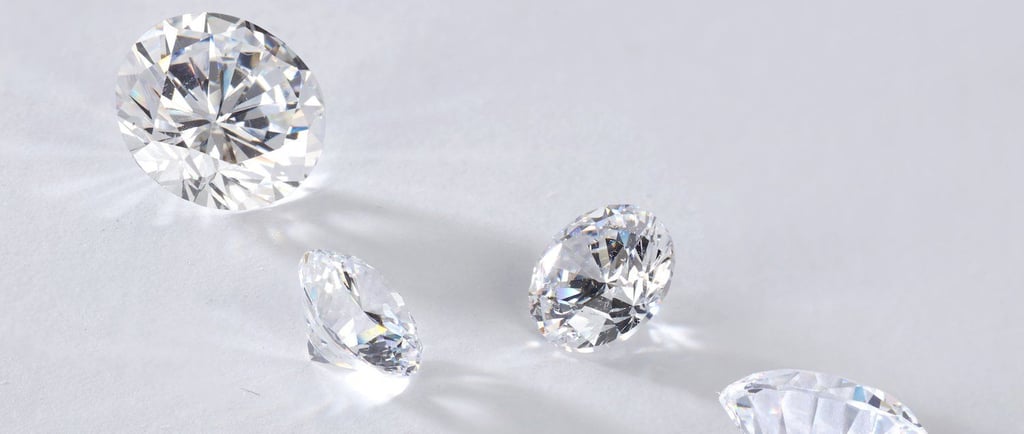Difference Between CVD Diamond and HPHT Diamond: What You Need to Know
Difference Between CVD Diamond and HPHT Diamond. While both are lab created diamonds, understanding their formation process can help you make an informed decision when buying diamond jewelry from Luxica Jewels.
CVD DIAMOND | LAB-GROWN DIAMONDS | LUXICA JEWELS
CVD Diamond
3 min read
As more people turn to sustainable and affordable alternatives to natural diamonds, lab grown diamonds have become the go-to choice for engagement rings, earrings, pendants, and more. Among lab grown diamonds, two popular types dominate the market: CVD Diamonds and HPHT Diamonds. While both are lab created diamonds, understanding their formation process can help you make an informed decision when buying diamond jewelry.
So, what is the difference between CVD diamonds and HPHT diamonds? And are they really that different? Let’s break it down.
What Are Lab Grown Diamonds?
Before diving into the difference, it’s important to understand that both CVD (Chemical Vapor Deposition) and HPHT (High Pressure High Temperature) diamonds are types of lab grown diamonds. Also known as man made diamonds, lab diamonds, or lab created diamonds, these gemstones are created in controlled laboratory environments that replicate the conditions under which natural diamonds form deep within the Earth.
They are physically, chemically, and optically identical to natural diamonds. This means lab grown diamonds have the same hardness, brilliance, fire, and luster.
CVD Diamond (Chemical Vapor Deposition)
CVD diamonds are created by placing a diamond seed in a vacuum chamber and filling it with carbon-rich gases. These gases are then ionized, breaking down the carbon molecules which bond to the seed, layer by layer, forming a diamond.
Advantages of CVD Diamonds:
Typically have better clarity
Grown at relatively lower temperatures and pressures
Often preferred for jewelry due to consistent quality
Can be enhanced further for color and clarity
HPHT Diamond (High Pressure High Temperature)
HPHT diamonds are created by replicating the natural conditions under which diamonds form in the Earth—extremely high pressure and temperature. A diamond seed is placed in carbon and subjected to intense heat and pressure until it crystallizes into a diamond.
Advantages of HPHT Diamonds:
Known for higher color grades, especially D-E-F range
Often used to improve the color of CVD diamonds
Great option for large or colorless diamonds
CVD vs HPHT: What’s the Real Difference?
While the processes of creating CVD diamonds and HPHT diamonds are different, both result in authentic lab grown diamonds. The key difference lies in the growth method, not in the final product's physical properties. Here’s a quick comparison:
Growth Method:
CVD (Chemical Vapor Deposition) diamonds are formed using carbon-rich gases in a vacuum chamber, where carbon atoms bond layer by layer to a diamond seed. HPHT (High Pressure High Temperature) diamonds are created by simulating natural diamond formation through extreme heat and pressure applied to a carbon source.Clarity:
CVD diamonds are often known for having better clarity, as their growth method generally results in fewer inclusions. HPHT diamonds may sometimes contain metallic inclusions due to the high-pressure process, although high-quality HPHT diamonds are also available.Color:
HPHT diamonds tend to have higher natural color grades (especially in the D-E-F range). On the other hand, CVD diamonds may show a slight brown or gray tint initially but can be treated post-growth to improve their color.Cost:
There is no significant price difference between CVD and HPHT diamonds. Both are priced similarly based on quality factors such as cut, clarity, color, and carat. Compared to mined diamonds, both are much more affordable.Eco-Friendliness:
Both CVD and HPHT diamonds are eco-friendly. They are grown in labs with minimal impact on the environment, making them a sustainable alternative to earth-mined diamonds.Durability:
Both CVD and HPHT diamonds are equally durable, scoring a perfect 10 on the Mohs hardness scale — just like natural diamonds. This makes them suitable for everyday wear in rings, earrings, and all kinds of fine jewelry.
Similar in Price and Eco-Friendly Benefits
Many customers ask whether there’s a price difference between CVD diamonds and HPHT diamonds. The answer is: they are priced similarly, depending on their size, color, clarity, and cut. Both are budget-friendly alternatives to mined diamonds, offering exceptional value for money.
Additionally, both types of lab grown diamonds are eco-friendly. Unlike natural diamond mining, which causes environmental degradation, CVD diamonds and HPHT diamonds are created with minimal ecological impact, making them a sustainable and responsible choice.
Final Thoughts
When it comes to CVD diamonds vs HPHT diamonds, there's no clear winner — both are lab grown diamonds with stunning beauty, durability, and brilliance. The choice depends on your personal preference, desired color or clarity, and the jeweler's recommendations.
Whether you choose a CVD diamond or an HPHT diamond, you can be confident that you're buying a real, high-quality, man made diamond that’s ethical, affordable, and indistinguishable from mined diamonds.
At Luxica Jewels, we offer both CVD diamonds and HPHT lab grown diamonds, crafted into stunning jewelry to match your style and values. Explore our collection today and find the perfect lab diamond that speaks to you.
About Us
Ethical elegance, certified! Shine responsibly with IGI / SGL & BIS Hallmark assurance, piece after precious piece.
Sustainable
Stay Connected
© 2025. All rights reserved.


